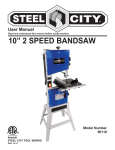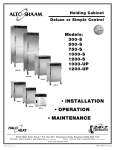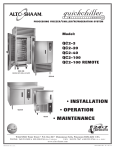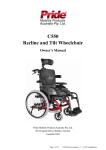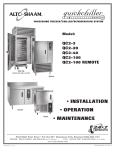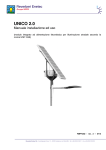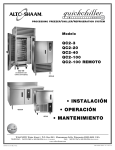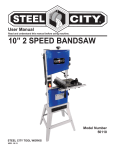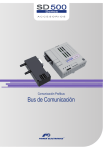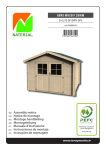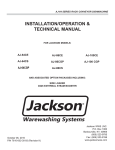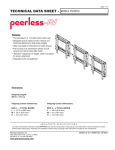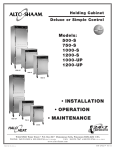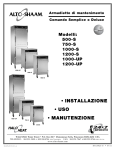Download Operating, installation and starting manual of the
Transcript
Operating, installation and starting manual of the telecommunications power supply system SDDB 300 SDDB 300-02 we ensure power supply I-207-511 Related documents: I-207-516 I-208-042 S13-030-01-01 Document revision Valid since Prepared by Approved by File name Operating manual of the microprocessor system type PI1 Alarms configuration Wiring diagram of the power supply system SDDB-300 A 19/12/2008 A.Baryś M. Zakrzewski SDDB300-PI1.doc TELZAS Sp. z o.o. ul. Bugno 3 78-400 Szczecinek tel. +48 94 37 29 787 fax. +48 94 37 29 800 www.telzas.com.pl [email protected] Manual – SDDB 300;SDDB 300-02 TELZAS – power guarantee Contents 1. SYMBOLS ......................................................................................................................................................3 2. SAFETY INSTRUCTIONS ...........................................................................................................................3 2.1. 2.2. 2.3. 2.4. 3. GENERAL INSTRUCTIONS............................................................................................................................. 3 SPECIAL INSTRUCTIONS ............................................................................................................................... 4 TRANSPORT AND STORAGE CONDITIONS ..................................................................................................... 4 CORRECT DISPOSAL OF THE PRODUCT ......................................................................................................... 4 GENERAL DESCRIPTION OF THE POWER SUPPLY SYSTEM ........................................................5 3.1. RECTIFIER PDD 48/55 .............................................................................................................................. 14 3.2. AC/DC DISTRIBUTION UNIT ...................................................................................................................... 15 3.3. CONTROL SYSTEM PI1 .............................................................................................................................. 17 3.3.1. Equipment configuration .................................................................................................................. 18 3.4. BATTERY CABINETS CBC, CBD, CBE ...................................................................................................... 19 4.SYSTEM INSTALLATION .............................................................................................................................23 3.5. LOCATION ................................................................................................................................................. 23 3.6. ELECTRIC CONNECTION OF THE POWER SYSTEM........................................................................................ 23 3.6.1. AC supplying of the power system .................................................................................................... 23 3.6.2. DC circuits ....................................................................................................................................... 24 3.6.3. Earth circuits .................................................................................................................................... 25 3.7. SIGNALLING CIRCUITS ............................................................................................................................... 26 3.7.1. External alarms ................................................................................................................................ 26 3.8. TEMPERATURE SENSORS ........................................................................................................................... 26 3.9. ADDITIONAL EXTERNAL SIGNALS CONNECTION ........................................................................................ 26 4. SYSTEM HANDLING ................................................................................................................................27 4.1. 4.2. 4.3. 4.4. 4.5. 4.6. 4.7. 4.8. 4.9. 5. TECHNICAL DATA OF THE POWER SUPPLY SYSTEM SDDB 300, SDDB 300-02 ......................29 5.1. 5.2. 5.3. 6. PREPARATION OF THE POWER SUPPLY SYSTEM FOR STARTING .................................................................. 27 STARTING, ADJUSTMENT AND TESTING OF RECTIFIERS .............................................................................. 27 NORMAL OPERATIONS – FLOAT CHARGING ............................................................................................... 27 EMERGENCY OPERATION ........................................................................................................................... 28 AUTOMATIC CHARGING ............................................................................................................................ 28 EQUALIZING CHARGING (PERIODIC CHARGING)......................................................................................... 28 BATTERY TEST .......................................................................................................................................... 28 REPLACEMENT OF THE RECTIFIER UNIT PDD 48/55 .................................................................................. 28 REPLACEMENT OF THE PI1 CONTROL SYSTEM’S MODULE. ........................................................................ 28 GENERAL DATA ......................................................................................................................................... 29 INPUT CIRCUIT PARAMETERS ..................................................................................................................... 29 OUTPUT CIRCUIT PARAMETERS ................................................................................................................. 29 TECHNICAL DATA OF BATTERY CABINETS ...................................................................................30 6.1. 6.2. 6.3. BATTERY CABINET CBE - 01/1540/3 ........................................................................................................ 30 BATTERY CABINET CBD - 03/1360/2 ........................................................................................................ 30 BATTERY CABINET CBC - 01/1140/2 ........................................................................................................ 30 Prepared by: Telzas Sp. z o.o. – A. Baryś Any solutions and data included in this document are exclusive property of Telzas Sp. z o.o. in Szczecinek and must not be used in any way without the company’s permit. Any part or the whole of this document cannot be duplicated, used in other publication or spread without the permit of Telzas Sp. z o.o. Telzas Sp. z o.o. reserves the right to introduce any changes or modifications of the data included in this document without any notice. All rights reserved. Revision A 19-12-2008 2 / 30 I-207-511 Manual – SDDB 300;SDDB 300-02 TELZAS – power guarantee 1. Symbols In this manual the following symbols are used to indicate paragraphs: Procedure Comment italics Document title, description under figure, software name or software menu Additional information Warning 2. Safety instructions Please read carefully the following notes. Failure to follow the specified recommendations may be a cause of very serious accidents as a result of which people working at the system handling may receive serious personal injury or even lose their lives. The following recommendations are in compliance with the law regulations being in force in different countries, defining conditions of safe work at the power supply equipment. The manufacturer does not take responsibility for consequences of any accidents caused by an inappropriate equipment operation coming from failure in observing safety conditions presented in this manual and relevant industrial safety standards for this type of power supply equipment. 2.1. General instructions • • • • • • The system can only be handled by personnel who have the appropriate qualification and experience in handling power supply systems and received the suitable training on the equipment in question by the manufacturer or its representative. When work is to be performed on or around the live equipment, the presence of an additional person is required; this person is responsible for work supervision and provides the first medical aid in case of electric shock. Any change of the system configuration by removing or adding any new component units (rectifiers or batteries) causes change of technical parameters of the power supply system. A user takes full responsibility for any consequences coming from the system configuration changes which are made without the manufacturer or its representative having been informed. The manufacturer allows some extent of service operations (e.g. replacement of a rectifier or functional module) to be performed by a user after previous training and agreeing the scope of the work needed. It is a user’s responsibility to ensure that only the authorized persons, who have the right knowledge about handling electric equipment, have an access to the room where the power supply system is installed. A user is responsible to provide appropriate climate conditions in the room where the power supply system is installed. If it is necessary, the room should be equipped with air conditioning. In other situations, provision of effective air exchange is required to ensure operating temperature in compliance with the specifications. The installation manual and specifications included at the end of this document form the necessary complement to these safety instructions. Precise fulfilment of the recommendations included in the installation manual as well as setting the system parameters according to the specifications ensures that the system is installed in the correct way and can be properly operated. Revision A 19-12-2008 3 / 30 I-207-511 Manual – SDDB 300;SDDB 300-02 TELZAS – power guarantee 2.2. Special instructions • • • • • • • During the system operation, some of its parts (such as rectifiers, fuses etc.) can get hot to relatively high temperature therefore the suitable protection measures is to be taken to avoid any burns. Fuses should only be removed by using the special fuse removers being designed for this purpose. Generally, it is recommended to remove fuse links at zero current flowing through the particular fuse. After removing a rectifier, some dangerous voltage can be present in its connection sockets for the period of 10 s from the moment of supply voltage disconnection. Because of this it is necessary to take some safety measures to avoid dangerous electric shock. When measurements of voltage and current are performed by using external measuring instruments being connected to the selected points of the power system, only suitable measuring equipment should be used (e.g. digital multimeter with high impedance inputs). Incorrect control of the system or its single units can cause change of the present operational status of the power supply system, appearance of false alarms or discharge of batteries being connected to the system. A person who is handling the system should be sure that its configuration is compliant with the specifications and the user’s requirements. Similarly, one shall make sure that the voltage levels of the power supply system are set correctly. Any incorrect settings can cause failure or reduction of battery service life. It shall also be checked whether the alarm levels (thresholds initiating alarms) are correctly set. Because, any incorrect setting values can result in false alarms or unjustified rectifier switching off. Any temporary values of the system control parameters to be set e.g. to perform testing of the power supply system must be cancelled each time when the system is restored to its normal operation mode. 2.3. Transport and storage conditions The SDDB power supply system should be transported and stored in the following climate conditions: • temperature –40...+70°C, • humidity < 90%, without condensation Moreover, to ensure safe transport, the power supply cabinet should be packed in the way which protects it against accidental mechanical damage, influence of dirt and water, scratching lacquer coat etc. During transport the power system and its component units cannot be subjected to: • continuous vibrations, • sharp shocks, • direct influence of weather conditions (rain, intensive sunlight). Failure to observe the aforementioned recommendations may result in serious damages of the power supply system, which in consequence leads to charging for repair costs, loosing guarantee or both of those results together. The responsibility for the transport belongs to a transport agent, but for the power system storage it is a user who is responsible. 2.4. Correct disposal of the product When the product operation life is finished, it should not be disposed with other waste materials. To avoid harmful influence of the uncontrolled waste disposal on the natural environment and people’s health, please separate this product from the other type of waste and contact your supplier to receive further details of conduct. Revision A 19-12-2008 4 / 30 I-207-511 Manual – SDDB 300;SDDB 300-02 TELZAS – power guarantee 3. General description of the power supply system The SDDB power supply systems are designed for uninterruptible power supply (with a battery connected in parallel) of DC telecommunications and network equipment such as: telephone exchanges, mobile phone base stations, servers, routers, etc. • • • • • • • • The power system design enables simple replacement of the most important units during system operation. The system of continuous power supply using the system SDDB provides: Protection of critical groups of loads against the consequences of mains failure. In the case of mains failure, batteries start supplying loads without any time delay. Accurate stabilization of DC voltage supplying the connected loads. Accurate voltage stabilization of the connected batteries at the level corresponding to its full charge state. This voltage can be compensated depending on the temperature changes in the room. Galvanic isolation between DC load circuits and AC power supply. The use of appropriate filters provides protection against electromagnetic interferences transmitted to or from the mains supply and to DC circuits. Continuous monitoring of the power system operation and quick reporting about alarm states. Flexible configuration and easy extension by using modules including individual components of the power supply system. Possibility of less important loads disconnection during the system operations in order to provide the best operation conditions for the most important loads. Owing to the use of modern electronic components and the recent solutions of switching circuits, high efficiency of the system was achieved – above 91%. Revision A 19-12-2008 5 / 30 I-207-511 Manual – SDDB 300;SDDB 300-02 TELZAS – power guarantee AC/DC distribution unit PI1 control unit Rectifier subrack Free space intended for installation of other devices Battery shelf Fig. 3.1. General view of the power supply system SDDB-300 in a single-piece cabinet. Revision A 19-12-2008 6 / 30 I-207-511 Manual – SDDB 300;SDDB 300-02 TELZAS – power guarantee Fig. 3.2. Pictorial diagram of the power supply system type SDDB-300 in the example configuration. The numbers in the figure 3.2 indicate the following system units: 1) AC distribution unit (AC connection module). 2) Rectifiers. 3) Battery protections. 4) Low voltage disconnectors in load circuits. 5) Load protections. 6) Microprocessor control unit. 7) System bars (-)SYS and (+)SYS. Rectifiers (2) are operated in parallel. Their outputs are connected to the common system bars (-)SYS and (+)SYS (7). The total current drawn by the supplied loads is equally shared between the individual rectifiers thanks to the use of active „load sharing” system. Batteries are connected to the system bars and in parallel to the rectifier outputs with the battery fuses FB1, FB2 (3). Loads are connected to the system bars by means of the low voltage disconnectors K1 and K2 (4) and load protections (5). The purpose of the disconnector is to disconnect the selected group of loads during battery discharge to protect batteries against harmfully deep discharge. The use of two low voltage disconnectors makes it possible to disconnect the non-critical load group earlier, and in this way allowing the battery back-up for the critical loads to be prolonged. The whole power system is supervised for correct operation by the control unit (6). It performs necessary measurements of electric parameters, controls operation of all main power system elements, ensures possibility of communication between the system and user, and sends the necessary alarm messages to the supervision centre in emergency conditions. Situation of the power supply system’s modules in various configurations in a single-piece cabinet and in a divided cabinet is shown in fig.3.3 – 3.8. Revision A 19-12-2008 7 / 30 I-207-511 Manual – SDDB 300;SDDB 300-02 TELZAS – power guarantee Distribution unit 10U Rectifier subrack 3U Free space 22U/18U/14U Battery shelf Battery shelf Fig. 3.3 Arrangement of the power supply system SDDB 300 in a single-piece cabinet – two battery shelves Hoppecke net.power 2x100Ah Revision A 19-12-2008 8 / 30 I-207-511 Manual – SDDB 300;SDDB 300-02 TELZAS – power guarantee Distribution unit 10U Rectifier subrack 3U Free space 18U/14U/10U Battery shelf Battery shelf Fig. 3.4 Arrangement of the power supply system SDDB 300 in a single-piece cabinet – two battery shelves Hoppecke net.power 2x150Ah Revision A 19-12-2008 9 / 30 I-207-511 Manual – SDDB 300;SDDB 300-02 TELZAS – power guarantee Distribution unit 10U Rectifier subrack 3U Free space 15U/11U/7U Battery shelf 7U Battery shelf 7U Battery shelf 7U Fig. 3.5 Arrangement of the power supply system SDDB 300 in a single-piece cabinet – three battery shelves Hoppecke net.power 3x100Ah Revision A 19-12-2008 10 / 30 I-207-511 Manual – SDDB 300;SDDB 300-02 TELZAS – power guarantee Distribution unit 10U Rectifier subrack 3U Free space 18U/14U/9U Battery shelf 7U Battery shelf 7U Fig. 3.6 Arrangement of the power supply system SDDB 300-02 in a divided cabinet – two battery shelves Hoppecke net.power 2x100Ah Revision A 19-12-2008 11 / 30 I-207-511 Manual – SDDB 300;SDDB 300-02 TELZAS – power guarantee Distribution unit 10U Rectifier subrack 3U Free space 14U/10U/5U Battery shelf 9U Battery shelf 9U Fig. 3.7 Arrangement of the power supply system SDDB 300-02 in a divided cabinet – two battery shelves Hoppecke net.power 2x150Ah Revision A 19-12-2008 12 / 30 I-207-511 Manual – SDDB 300;SDDB 300-02 TELZAS – power guarantee Distribution unit 10U Rectifier subrack 3U Free space 11U/7U/2U Battery shelf 7U Battery shelf 7U Battery shelf 7U Fig. 3.8 Arrangement of the power supply system SDDB 300-02 in a divided cabinet – three battery shelves Hoppecke net.power 3x100Ah Revision A 19-12-2008 13 / 30 I-207-511 Manual – SDDB 300;SDDB 300-02 TELZAS – power guarantee The power supply system SDDB can also be operated without the microprocessor control unit. This feature is especially important in the case of service operations. The replacement or switching off one of the control system’s units does not involve the necessity of the system switching off. Similarly, in case of failure of one of the modules, the power system does not have to be switched off. 3.1. Rectifier PDD 48/55 The rectifier PDD 48/55 is used to supply directly equipment with direct current. The supplied equipment allows widened range of supply voltage changes and includes especially modern telecommunications systems for nominal supply voltage of 48V. The rectifier also provides the possibility of automatic battery charging up to 2.43V/cell. Maximal rectifier current is 55A. It was constructed based on a recently patented technology of high frequency energy processing with DSP function (Digital Signal Processor). This function stands for smaller quantity of elements, optimal operation, better regular current spread among the rectifiers providing effective rectifier’s operation. Moreover the rectifier is equipped with the PFC system which provides sinusoidal current consumption from the grid. The communication of control unit PI1 with the rectifier is carried out through the CAN bus-bar. The rectifier’s output parameters adjustment is implemented by digital communication, as well as sending control signals for particular operating modes and alarm signals reception from particular rectifiers. The rectifiers are made in „hot-swap” technology which means that connection of the rectifier to the system does not need any cable connections (all connections are carried out with built-in plugs and sockets at the back of the rectifier). The rectifiers are installed in subracks. In the system cabinet it is possible to install 6 pcs of rectifiers. Revision A 19-12-2008 14 / 30 I-207-511 Manual – SDDB 300;SDDB 300-02 TELZAS – power guarantee 3.2. AC/DC distribution unit a/ DC part Depending on the user’s requirements, the power system SDDB can be equipped with or extended by different types of DC distribution units. Their basic function is to allow a user to use any configuration of NH00 fuse disconnectors or overcurrent circuit-breakers (MCB). The configuration of each DC distribution unit can include two low voltage disconnectors (LVDs) used to protect a battery against deep discharge and for selective disconnection of load groups. The contactors K3 and K2 disconnect the groups of non-critical loads, and the contactor K1 disconnects the battery. In the part of the DC distribution unit there are also battery protections and a shunt to measure the battery total current. As standard there are three protections type NH00 160A with the possibility of extension up to five protections. Load protections (critical ones) Local bar (+)SYS Fuse monitoring system UKB LVD contactor of battery disconnection Load protections (non-critical ones) Contactor of non-critical loads Fig.3.2.1. View of the AC/DC distribution unit. Revision A 19-12-2008 15 / 30 I-207-511 Manual – SDDB 300;SDDB 300-02 TELZAS – power guarantee b/ AC part and interfaces The AC part of the distribution unit comprises the terminals for connection of AC mains supply and the phase failure sensor KZF-2. The AC terminals make it possible to connect power supply with three independent single-phase lines 3 * (L+N+PE). The AC terminals are installed in the top part of the distribution unit. Input protections of rectifiers Battery protections Mains terminals and KZF system Interfaces of the PI1 control system Fig.3.2.2. View of the AC/DC distribution unit. Revision A 19-12-2008 16 / 30 I-207-511 Manual – SDDB 300;SDDB 300-02 TELZAS – power guarantee c/ battery asymmetry monitoring The power supply system SDDB is equipped with the battery asymmetry monitoring board. The board is installed in the group of measuring and communication interfaces. Installation of the battery asymmetry monitoring board is carried out during the production process and no handling operations are required during the system operation. However, it may be necessary to add some cabling for auxiliary batteries. The application of the contacts on the connectors Z1, Z2 and Z3 is given below. Original cable bundles, delivered together with the equipment or ordered from the power system manufacturer, should be used to run measuring cabling of batteries. 1 2 3 4 Z3 5 6 1 2 3 4 Z1 5 6 Connector Z1. Contact No.: 1 BAT1(+) 2 BAT1(centre) 3 BAT1(-) 4 BAT2(+) 5 BAT2(centre) 6 BAT2(-) Connector Z2. Contact No. 1 BAT3(+) 2 BAT3(centre) 3 BAT3(-) 4 BAT4(+) 5 BAT4(centre) 6 BAT4(-) Connector Z3 Contact No. 1 Alarm contact NO 2 Alarm contact C 3 Alarm contact NC 4 Power supply (-) 5 n/a 6 n/a 1 2 3 4 Z2 5 6 Fig.3.2.3 3.3. Control system PI1 In the SDDB power system the flexible PI1 type control unit was applied. The control unit design is based on the distributed network architecture comprising numerous units i.e. intelligent peripheral devices. The CAN Bus (Controller Area Network) is used to connect elements of this network. Each of the units provides adaptation of supervision/control elements to the uniform data exchange protocol. Such idea ensures open system which makes it possible to configure a unit connected to the system in automatic way and allows, without major limitations, to extend the control system with new functions (saving hitherto existing functions and implemented periphery functions). It is to be emphasized that any service exchange of the module does not cause stopping of functions performed by the other module of the supervised system. In a standard version the PI1 control system is equipped with user’s interface with local OLED type display and RS232 connector or USB enabling the connection with the PC. The configuration of the parameters can be executed from the level of the display as well as within the connected computer. There is also a possibility of a remote communication through the modem and online connections. Note: Remote configuration of the controller is possible only by means of TCP/IP protocol. In a standard version the control unit enables the following functions (other functions available on application): • • • • • • • • • monitoring of output voltage of the power supply system, total battery current measurement, ambient battery temperature measurement, float operation mode, forcing of automatic charging operations mode, forcing of equalizing charging operations mode, forcing of operations with the generator mode, temperature compensation of battery charging voltage, monitoring of output voltage – setting alarm thresholds for the system’s low and high voltage and rectifiers blocking voltage, Revision A 19-12-2008 17 / 30 I-207-511 Manual – SDDB 300;SDDB 300-02 • • • • • • • • • • • • TELZAS – power guarantee monitoring of loads’ fuse blow-out, monitoring of battery’s fuse blow-out, battery asymmetry monitoring, battery disposition test function, structure memory of chosen parameters after the battery discharge, limitation of battery charging voltage, load groups management function, operation of the power supply system based on combustion generator system alarm visual presentation, sending alarm signal as potential-free contact, local (display, RS232-PC) and remote (WinCN) regulation of the power supply system’s and alarm’s operation parameters configuration, remote communication – analogue modem, GSM, Ethernet. The signalling systems of the control unit enable to send information about the operations status and alarm states of the power supply system to the supervisory centre. Sending the signals is executed by means of potential-free change-over contacts placed on the input terminals list of MWW module of the control system. Note: The uniform flow of rectifiers’ output currents is executed without the participation of PI1 control unit. Optional functions of PI1 control unit: • • three-phase mains monitoring, monitoring of the object 10 input analogue-digital signals and 10 output signals (switchable potential-free contact of the relay) with the configuration possibility. 3.3.1. Equipment configuration The composition of the PA1 control system fulfils the following assumptions: - battery service module (MOB) – responsible for: • • • • • • • • • • • • • control of output voltage of the system – regulated level of low and high voltage control of battery ambient temperature – regulated level of low and high temperature control of second temperature – regulated level of low and high temperature float charging mode, automatic charging mode, equalizing charging mode, operation with generator mode, temperature compensation of output voltage, limitation of battery charge voltage, automatic battery test, loads’ groups management, RS232/USB interface for PI1 system configuration by means of PC software – socket on MU module, power supply for base modules – voltage of about 7,5VDC, distributed through the communication cable (local CAN bus), - user’s module (MU) – responsible for: • alarm states visualisation, • measurements visualisation, • parameters adjustment, - module of communication with the rectifiers (MPC) – responsible for: • maintenance of required output voltage, • limitation of battery charging current, • reading of particular rectifiers’ currents, Revision A 19-12-2008 18 / 30 I-207-511 Manual – SDDB 300;SDDB 300-02 • • TELZAS – power guarantee reading of particular rectifiers’ alarm states, execution of total rectifiers’ current equalization between two cabinets, - current measurement module (MPP): a/ for total battery current measurement – only base board, b/ for particular batteries’ current measurement – additional measurement rectifiers (max 3) included in base board. MPP, is responsible for: • battery current measurement, with the application of a shunt as a current sensor, - input-output module (MWW) – responsible for: • measurement and control of 7 analogue – digital inputs 0..5VDC, • control of 3 digital inputs TTL 5V, • control of 10 relays with outputs as switchable potential-free contacts, - communication module (MK-RS) – responsible for: • preparation of a data pack comprising up to 4096 signals, • setting the connection through the external GSM modem (Wavecom FS20) or ModIP converter, - history module (MH) – responsible for: • time and date source (RTC) • registration of the states appearing in local CAN bus (up to 120.000 events), - asymmetry interface – responsible for: • asymmetry signalisation for 4 batteries in a shape of potential-free contact, - optional AC mains interface monitoring (MMS) – responsible for: • measurement and control of three phase AC voltages • measurement and control of voltage frequency of AC mains, • measurement of each AC phase’s current. Full description of the control unit is included in manual I-207-516. 3.4. Battery cabinets CBC, CBD, CBE Battery cabinets: CBC - 01/1140/2, 1140mm high, with two battery shelves, CBD - 03/1360/2, 1360mm high, with two battery shelves, CBE - 01/1540/3, 1540mm high, with two battery shelves, are intended for installation of additional batteries. In case of a cabinet with two shelves, it is possible to install in maximum 2 sets of batteries of a capacity up to 150Ah. While in case of a cabinet with three shelves in maximum 3 sets of a capacity up to 100Ah. The cabinets are adjusted to conveying the cables from the top through the roof with appropriate cableways with a possibility of fastening the conveyed cables. The free space in the cabinets can be used for installation of additional 23” equipment or also, by means of special adapters, 19” equipment. Revision A 19-12-2008 19 / 30 I-207-511 Manual – SDDB 300;SDDB 300-02 TELZAS – power guarantee Free space 18U/14U/9U Battery shelf 7U Battery shelf 7U Fig. 3.4.1 Arrangement of the battery cabinets CBE/CBD/CBC – two battery shelves Hoppecke net.power 2x100Ah Revision A 19-12-2008 20 / 30 I-207-511 Manual – SDDB 300;SDDB 300-02 TELZAS – power guarantee Free space 14U/10U/5U Battery shelf 9U Battery shelf 9U Fig. 3.4.2 Arrangement of the battery cabinets CBE/CBD/CBC – two battery shelves Hoppecke net.power 2x150Ah Revision A 19-12-2008 21 / 30 I-207-511 Manual – SDDB 300;SDDB 300-02 TELZAS – power guarantee Free space 11U/7U/2U Battery shelf 7U Battery shelf 7U Battery shelf 7U Fig. 3.4.3 Arrangement of the battery cabinets CBE/CBD/CBC – three battery shelves Hoppecke net.power 3x100Ah Revision A 19-12-2008 22 / 30 I-207-511 Manual – SDDB 300;SDDB 300-02 TELZAS – power guarantee 4.System installation 3.5. Location • • • • • • • The power supply system SDDB is intended for installation in rooms inside the buildings. The following conditions should be met: The power system room should be locked, dry, free from dust, clean and airy, free from gases and vapour of aggressive chemical substances such as sulphuric acid. The permissible ambient temperature of the power supply system (during the system operation) is from 5C to +40C. It is recommended to maintain the temperature within the range from +5C to +25C. The relative humidity in the area around the power system should not exceed 95% (at temperature of 20C). At the place of installation the suitable operating conditions should be provided (free space, access to the system) allowing inspections and repairs. The distance between the top cover of the system cabinet and the room ceiling must be at least 0.5 m (to ensure heat dissipation). From the front of the power system there should be provided free space of at least 1 m to enable easy access to rectifiers. During the guarantee period, the power system cannot be moved from the installation location without informing Telzas Sp. z o.o. or the technical representative authorized by the company. During selection of the power system operation location, one shall take into consideration the necessity to provide the suitable air exchange in the room to maintain the optimal temperature in the direct vicinity of the system. It is recommended to provide air conditioning in the power system room. Such a location of the power system ensures optimal operating conditions and increases reliability and service life in a significant way. 3.6. Electric connection of the power system Any connections shall be performed in dead state (power off). For this purpose an input circuit-breaker shall be set to OFF position or the suitable fuses shall be removed in the AC distribution board. The input protections of the rectifiers located in the AC connection module should also be switched off. Before starting connection of AC and DC circuits to the power supply system, the up-todate schematic diagram of electric circuits should be studied. The project of AC supply cabling, DC distribution cabling, battery circuits and installation work itself should be performed by people having the right qualifications and licenses. The installation should be made in accordance with the standards and regulations being in force. 3.6.1. AC supplying of the power system A. General information The typical power supply system SDDB is supplied with 3x230/400 Vac three-phase AC supply. It is recommended to select protection sizes and AC supply cable cross-sections with taking into consideration maximal number of rectifiers which can be installed in the power system even if at the moment of installation the configuration is not complete. The AC connection module is equipped with serial terminals allowing connection of three-phase supply line with the cross-section of cable up to 16 mm2. The triple N and PE terminals make it possible to connect three independent single-phase supply lines after previous removal of the bridges. B. LV distribution board / power supply field of the system For supplying of the power system a separate LV distribution board should be provided (or the separate field in the main switchgear). Any supplying of the power supply system from the temporary distribution boards is not allowed. The power system and supply line protections are Revision A 19-12-2008 23 / 30 I-207-511 Manual – SDDB 300;SDDB 300-02 TELZAS – power guarantee required in the distribution board field against effects of short-circuits in the AC supply circuits. In case of the standard power supply it is recommended to install fuses. Quantity of rectifiers Configuration of the system AC supply line Max. input current of the rectifier Max. phase current of the system Fuse size Cable crosssection 3 3xL + N + PE 18,0 Aac 18,0 Aac 25 A 5 x 4 mm 2 6 3xL + N + PE 18,0 Aac 36,0 Aac 40 A 5 x 6 mm 2 Table 2. Recommended protection sizes and cable cross-sections in the supply circuits of the power supply system SDDB-300. C. Surge protection In their standard versions the power supply systems SDDB are not equipped with surge arresters – the surge protection is provided in the board which the power supply system is supplied from. Optionally, it is possible to install surge arresters in the AC field of the power system. D. Supply line The supply line should be made with the five-core cable (3xL+N+PE). The supply cable conductors shall be connected to the serial terminals located at the right side of the distribution unit as shown in the figure 3.3b. Only copper cables with at least nominal insulation voltage of 750V can be used. The recommended cable cross-sections are given in the table 2. Fig. 4.1. Method of the cable connection to the serial Wago type terminals. You are not allowed to connect any other loads to the circuit from which the power system is supplied. 3.6.2. DC circuits A. Connection of DC loads The positive terminals of loads are to be connected directly to the terminals located on the local positive (+) bar of the distribution module. The negative terminals are to be connected to the top terminals of the load protections. In the case of the fuse disconnectors type NH00, fix the cables directly to the top terminals on the fuse bases. B. Connection of batteries Battery connection modules are used to connect batteries. The positive terminals are to be connected to the free holes located at the top or bottom of the (+)SYS bar (the cables should be equipped with the cable lugs). The negative terminals are to be connected to the appropriate terminals of the bases of the fuse disconnectors NH00 located in the battery connection module. In case of the cables connected to the load protections type MCB, the cables should be provided with sleeves at their ends. The maximal cross-section of the negative cables (-) 2 which can be connected to the load protections (MCB) is 25 mm . Revision A 19-12-2008 24 / 30 I-207-511 Manual – SDDB 300;SDDB 300-02 3.6.3. TELZAS – power guarantee Earth circuits The telecommunications power system SDDB must be suitably connected to the site earth system. The way how the cabling is to be done is defined each time in the installation project of the whole power plant in which the power system is to be operated. The project must take into consideration the specific features of the given site and the user’s specific requirements in this respect, and above all ensure the safe power system operation both in the case of appearing dangerous AC voltage at the enclosure from the mains side and as well as from DC voltage. In the first case the health hazard may be caused by the dangerous voltage on the metal cabinet walls, and in the second case after the short-circuit between the cabinet walls and negative pole of DC circuits, the high currents may flow, causing dangerous thermal effects. Both hazards are limited by using the suitable system of earth and protective connections, and input and output system protections. The anti-shock protection from the AC supply side is received mainly by galvanic connection of the cabinet construction with its all metal elements to the PE protective conductor of the AC power supply and by the use of suitable protections in the input AC circuits of the power system. Version I of the earth circuit connection: 1) Connection of the positive bar to the site earth collector bar. 2) Connection of the cabinet metal construction (PE bar) to the site earth collector bar. 3) Using fuses or overcurrent circuit-breakers located in the load and battery circuits. Version II of the earth circuit connection (economical one): 1) Connection of the positive bar to the site earth collector bar, 2) Connection of the positive bar to the cabinet metal construction (PE bar), 3) Using fuses or overcurrent circuit-breakers located both in the load and battery circuits. Because the short-circuit currents in the DC circuits may have considerable values, to provide connections mentioned in version I and II it is necessary to use cable cross-sections adapted to the maximal short-circuit current of the given power system. L OADS L OADS BATT ERIES BAR (+) BAT TERIES BAR ( +) SIT E EART H COLLECTOR BAR (- ) SITE EART H COLL ECT OR BAR BAR BAR ( -) PE BUS + POWER SUPPLY SYST EM ~ - PE BU S + POWER SUPPLY SYST EM = . INPUT T ERM INAL S ~ - = . INPUT TERM INALS F UNCT IONAL FUNCTIONAL EARTHING LV DISTRIBUT ION UNIT L 1 L2 L3 N PE PE EARTHING LV DI ST RIBUT ION UNIT Version I L 1 L 2 L 3 N PE PE Version II Fig. 4.3. Connection of the power supply system SDDB to the site earth system. Revision A 19-12-2008 25 / 30 I-207-511 Manual – SDDB 300;SDDB 300-02 TELZAS – power guarantee 3.7. Signalling circuits Signalling and measuring cables shall be connected directly to the MWW module in accordance with the description in the operating manual of the control unit I-207-516. 3.7.1. External alarms Alarm circuits shall be connected to the sockets according to the description in the operating manual of alarms configuration I-208-042. 3.8. Temperature sensors The temperature sensor shall be placed in a battery room (or in battery cabinet) in a way allowing to measure ambient temperature directly in the surroundings of batteries. A free cable end of the temperature sensor terminated with the connector is to be run to the installation place of the power system and connected inside PI1 controller’s panel according to the description in the operating manual of the control unit I-207-503. 3.9. Additional external signals connection Additional external signals (two-status) shall be connected to the MWW module of the PI1 controller according to the description in the operating manual of the control unit I-207-516. Revision A 19-12-2008 26 / 30 I-207-511 Manual – SDDB 300;SDDB 300-02 TELZAS – power guarantee 4. System handling 4.1. Preparation of the power supply system for starting To achieve the correct installation and start of the power supply system SDDB, the following operations should be done: 1) After unpacking, check the system for any damages caused in transport. 2) Check type and number of items according to the order. 3) Install all modules in the power system cabinet. 4) Check if all connections of the power system, described in the chapter on power system installation (chapter 4), are performed correctly. 5) Check if AC supply voltage supplying the power system is switched off. 6) Remove DC load fuses and set load circuit-breakers or turn to OFF position (switched off). 7) Remove battery fuses from the fuse bases. 8) Set the input circuit-breakers of the rectifiers to OFF position (switched off). 9) Insert rectifiers into the power supply system. 10) Connect the test load resistor to biggest of the load protections. 4.2. Starting, adjustment and testing of rectifiers Set the input protections of the rectifiers to ON position. 1) Switch on the load protection to which the load resistor is connected. 2) Check and correct, if required, level of rectifiers blocking voltage (refer to operating manual of the control unit I-207-516). 3) Check and correct, if required, rectifier output voltages (refer to operating manual of the control unit I-207-516). 4) Load the power system with the current corresponding to at least 50% of its nominal current. 5) Check the operation of the equal load sharing system by observing output current measurements of individual rectifiers. One of the rectifiers may show the output current value different than the other rectifiers in the system. This difference should not exceed 1% of the maximal output current value of the particular rectifier type. 6) 7) 8) Check the operation of the rectifier LEDs in the state of normal system operation, and in simulation of emergency operation (the rectifier input circuit-breaker is switched off). After finishing tests, disconnect the test load resistor from the system. Insert all fuse elements into the appropriate fuse bases and set the load overcurrent circuitbreakers to ON position. After finishing the above operations, the power supply system SDDB provides power to loads and protects them against any mains failure. 4.3. Normal operations – float charging In the normal operation mode, load circuits, rectifier outputs and batteries are connected in parallel. The rectifiers rectify the incoming electric energy from the AC power network into 48V DC power energy, and supply it to the loads being supplied by the power system and to batteries. The main battery fuses are installed in the fuse bases FB1,..., FBn. The system output voltage and parameters of temperature compensation are set as the control unit parameters at the level of optimal battery back-up voltage. This voltage can, if needed, be compensated according to battery temperature changes (refer to the description of setting the system float voltage and parameters of the temperature compensation function in the operating manual of the control unit). Revision A 19-12-2008 27 / 30 I-207-511 Manual – SDDB 300;SDDB 300-02 TELZAS – power guarantee 4.4. Emergency operation This operation occurs e.g. in the case of mains supply failure. The configuration of the power system connections is the same as for normal operation mode. The electric energy is drawn from the batteries. 4.5. Automatic charging In automatic charging mode, the configuration of the power system connections is the same as for float operation mode. The difference between the automatic charging and float charging is that automatic charging is performed with higher voltage value, which means that the time required to charge batteries is shorter. The value of this voltage is set in the control unit menu. Automatic charging is an alternative to the float charging and can be started automatically after the mains failure. It can also be initiated manually by a user to recharge the battery (refer to the description of automatic charging function in the operating manual of the control unit). 4.6. Equalizing charging (periodic charging) The equalising charging like the automatic charging is an optional battery charging mode. The purpose of it is to equalise the voltage differences between individual battery cells by their periodic charging with the raised voltage value. It is initiated automatically by the control unit in the programmed intervals or to the user’s direct command. The configuration of the power system connections is the same as for normal operation mode. 4.7. Battery test The battery test is a function to be performed as an option. It enables a user to check battery condition. The battery test can be initiated automatically by the control unit in the declared intervals or started manually by a user. The configuration of the power system connections is the same as for normal operation mode. The battery test parameters are defined in the control unit menu (refer to operating manual of the control unit I-207-516). 4.8. Replacement of the rectifier unit PDD 48/55 To perform efficient and safe replacement of the rectifier type PDD 48/50 in the power supply system SDDB, the following should be done: 1) Identify the rectifier which is subject to replacement. The rectifier failure states are signalled on its front plate (red LED) and on the display of the control unit MCSU. 2) Set the rectifier input circuit-breaker to OFF position. 3) By using the rectifier handle push and remove the unit out of the rectifier sub-rack and then slide the new rectifier into this place. 4) After setting the rectifier input circuit-breaker back to ON position, the new rectifier is started. A few second addressing process and setting is performed automatically as soon as the control unit detects presence of the new rectifier in the system. 4.9. Replacement of the PI1 control system’s module. For safety of the loads, the time of the power system operation without the control unit in working order should be limited to the necessary minimum. To perform efficient and safe replacement of the controller’s module the following should be done: 1) Disconnect the cables from the controller’s module. 2) Ensure the continuity of the CAN bus in the place of removed module. 3) After replacement of the module, connect the cables back. 4) The control unit is ready to the operation. Note: 1. After removing a damaged module the control system is void of only these functions, that were fulfilled by this particular module. Other modules perform their standard functions provided that the removed module did not transmit the input data necessary to their standard operation. Otherwise the functions of these modules are also limited. 2. After removing a damaged module the break in a CAN bus should be filled with an additional cable connecting free CAN inputs of adjacent modules in order to ensure power supply and transmission of data among the modules. Revision A 19-12-2008 28 / 30 I-207-511 Manual – SDDB 300;SDDB 300-02 TELZAS – power guarantee 5. Technical data of the power supply system SDDB 300, SDDB 300-02 5.1. General data Type and maximal number of rectifiers PDD 48/55 2-6pcs. Type of the control unit supervising power system’s operation PI1 Utilization height for the customer’s equipment see p. 3.3-3.8 External dimensions of the cabinet: width depth height 600mm 600mm 2183mm (+ regulated foots 26 ÷ 44 mm) option 2003mm (+ regulated foots 26 ÷ 44 mm) option 1826mm (+ regulated foots 26 ÷ 44 mm) Weight (without rectifiers and batteries) 90kg Weight of rectifier PDD 48/55 3,5 kg System efficiency ≥ 91% Electromagnetic compatibility according to PN-EN 300-386 Safety requirements according to EN 60 950 Protection degree IP 20 Cooling forced Noise level <50dBA 5.2. Input circuit parameters Input voltage 184...253 VAC Frequency 45...65 Hz Mains supply configuration 3W+ N+ PE Power factor ≈1 Mains voltage monitoring yes Rated phase voltage of the power supply system (for two rectifiers per phase, 230VAC, 53,5VDC) 28 AAC (2x14AAC) 5.3. Output circuit parameters Adjustment range of output voltage 48...58 VDC Maximal output current for power system 6 x PDD 48/55 330ADC Maximal output power for power system 6 x PDD 48/55 19140W (6x3190W) Accuracy of load sharing for load >20% Inom of rectifier ± 5% Inom of rectifier Stabilization of output voltage ± 1% Output voltage ripples: psophometric value ripples and peaks (peak-to-peak value) Revision A 19-12-2008 < 2 mV < 200 mV 29 / 30 I-207-511 Manual – SDDB 300;SDDB 300-02 TELZAS – power guarantee 6. Technical data of battery cabinets 6.1. Battery cabinet CBE - 01/1540/3 External dimensions of the cabinet: width depth height Internal arrangement 600mm 600mm 1514mm (+ regulated foots 26 ÷ 44 mm) fig.3.4.1, 3.4.2, 3.4.3 6.2. Battery cabinet CBD - 03/1360/2 External dimensions of the cabinet: width depth height Internal arrangement 600mm 600mm 1336mm (+regulated foots 26 ÷ 44 mm) fig.3.4.1, 3.4.2, 3.4.3 6.3. Battery cabinet CBC - 01/1140/2 External dimensions of the cabinet: width depth height Internal arrangement Revision A 19-12-2008 600mm 600mm 1113mm (+regulated foots 26 ÷ 44 mm) fig.3.4.1, 3.4.2, 3.4.3 30 / 30 I-207-511






























